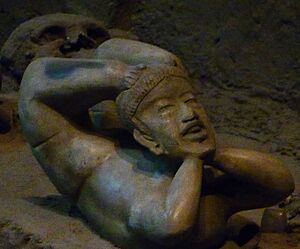Tlatilco facts for kids
Tlatilco was an important ancient village in the Valley of Mexico. It was located near what is now Mexico City. This village was one of the first major centers to grow in the Valley. It thrived on the western side of Lake Texcoco a long, long time ago, between 1200 BCE and 200 BCE. This time is known as the Middle Pre-Classic period in Mesoamerica. The name "Tlatilco" is also used for a wider ancient culture. This culture included another town called Tlapacoya, which was on the eastern side of Lake Chalco.
Tlatilco is especially famous for its amazing pottery. Many of these pottery pieces show designs from the Olmec people, who were another important ancient culture. Tlatilco also had many small statues, called figurines. Some of these figurines looked like Olmec "baby-face" figures. However, many other items found at Tlatilco seem to be made in their own unique style. The Olmec-style items have made experts wonder how much the Olmec culture influenced other groups like the Tlatilco people.
Discovering Ancient Tlatilco
In more recent times, the Tlatilco site was used to get clay for making bricks. As people dug for clay in the 1930s, they found many ancient objects. These objects ended up with collectors, like the artist and expert Miguel Covarrubias. He led the first careful dig at the site in 1942.
By 1949, archaeologists had found over 200 ancient burials at Tlatilco. This led them to think it was mainly a burial ground, or a "necropolis." Later, two more big archaeological digs happened. Eventually, over 500 burials were found. Many of these burials still had the gifts that were placed with the people.
During the last dig, experts also looked at other structures, not just burials. They realized that many of these hundreds of burials were actually under where ancient houses used to be. They also found burials among old trash pits. This showed that Tlatilco was not just a burial ground. It was a large, important village and a major center for its people.
Life in Tlatilco
The people of Tlatilco were farmers. They grew a lot of maize, which is corn. They also grew beans, a plant called amaranth, squash, and chili peppers. To add to their food, they hunted various animals. These included birds like migratory ducks, wild rabbits, and other small mammals. They also hunted deer and antelope.
Tlatilco was at its most powerful and important between 1000 BCE and 700 BCE. This was during a time when Olmec culture had a wide influence. After this period, from 700 BCE to 400 BCE, the Tlatilco people stopped using Olmec designs and styles in their art. This new time is called the Zacatenco phase.
Unique Tlatilco Figurines
Many of the small statues, or figurines, found at Tlatilco are very interesting. Some show unusual features or what look like deformities. For example, there is a "duality" mask that seems to show two faces joined together. There are also several female figures that have two heads. Because of these unique finds, some researchers have wondered if Tlatilco might have been a place where conjoined twins lived or were especially honored.
The name "Tlatilco" comes from the Nahuatl language. In Nahuatl, it means "in the place of mounds."
See also
 In Spanish: Tlatilco para niños
In Spanish: Tlatilco para niños



